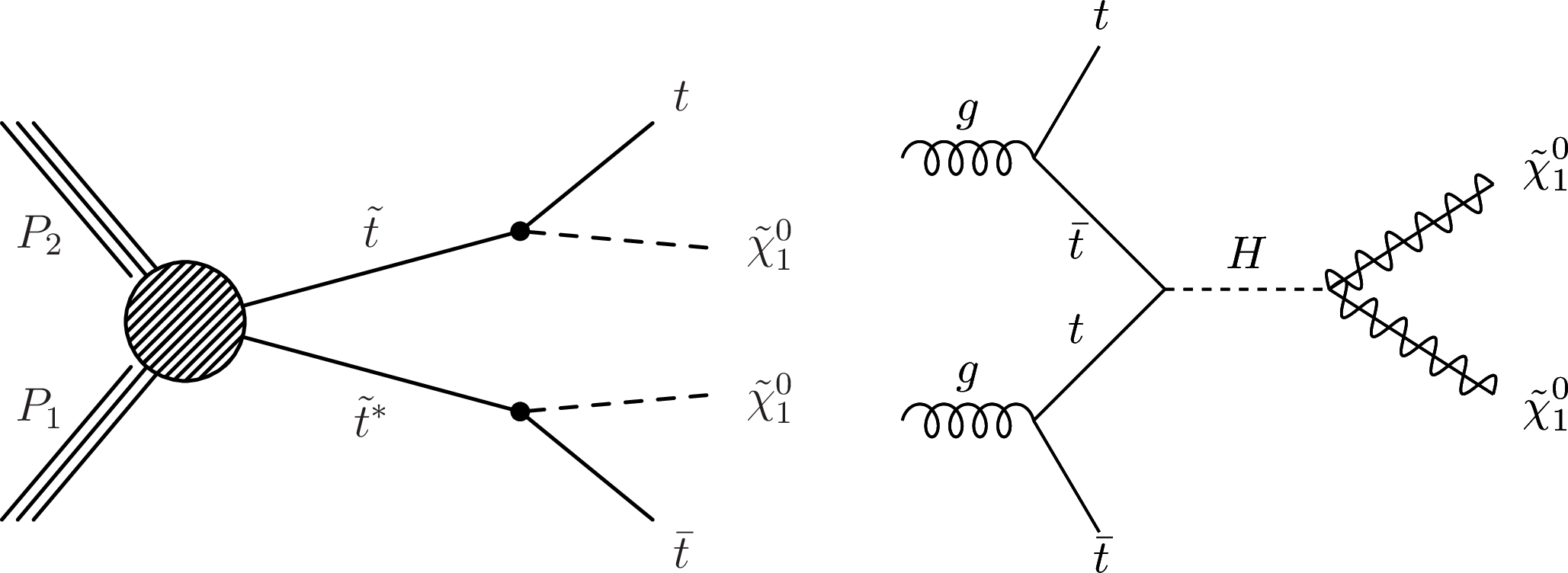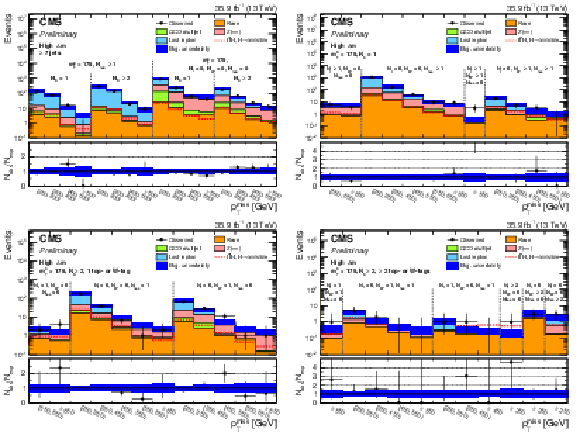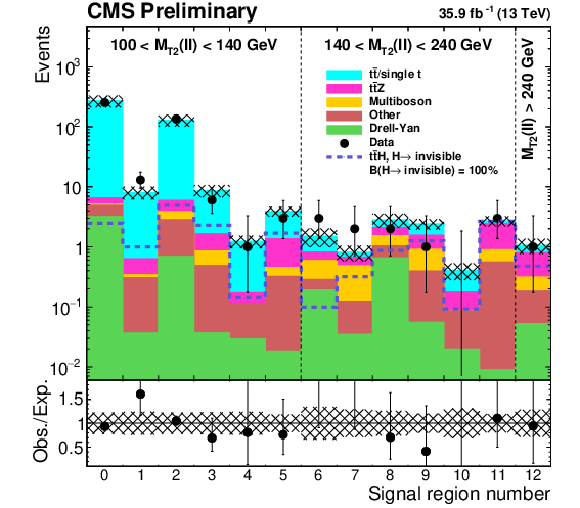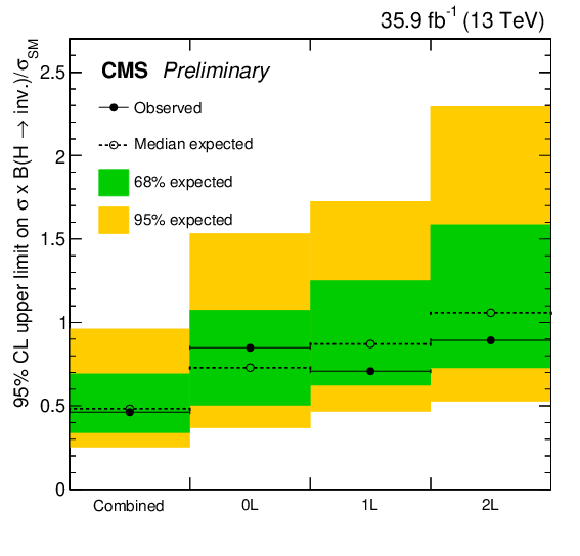

Compact Muon Solenoid
LHC, CERN
| CMS-PAS-HIG-18-008 | ||
| First constraints on invisible Higgs boson decays using $\mathrm{t}\bar{\mathrm{t}}\mathrm{H}$ production at $\sqrt{s}= $ 13 TeV | ||
| CMS Collaboration | ||
| March 2019 | ||
| Abstract: This document presents first upper bounds on the branching fraction of the Higgs boson to invisible particles using an event topology corresponding to production of the Higgs boson in association with a top quark pair. This is done by reinterpreting results of the searches for scalar top quarks performed in the all-hadronic, the semi-leptonic, and the di-leptonic final states. Proton-proton collision data at $\sqrt{s}= $ 13 TeV is used, recorded with the CMS detector at the CERN Large Hadron Collider in 2016 and corresponding to an integrated luminosity of 35.9 fb$^{-1}$. An observed (expected) upper limit of $\mathcal{B}(\mathrm{H}\to\mathrm{inv}) < $ 0.46 (0.48) is set on the branching fraction of the Higgs boson decaying to invisible particles at the 95% confidence level, assuming standard model $\mathrm{t}\bar{\mathrm{t}}\mathrm{H}$ production cross section. | ||
| Links: CDS record (PDF) ; inSPIRE record ; CADI line (restricted) ; | ||
| Additional information on efficiencies needed for reinterpretation of these results are available here. Additional technical material for CMS speakers can be found here |
| Figures | |

png pdf |
Figure 1:
Example leading-order diagram corresponding to pair production of top squarks ($ {\tilde{\mathrm {t}}} {\overline {\tilde{\mathrm {t}}}} $) predicted by SUSY (left). The process results in the production of two top quarks and ${{p_{\mathrm {T}}} ^\text {miss}}$ corresponding to undetected neutralinos. The same topology can be produced via a $ {{{\mathrm {t}\overline {\mathrm {t}}}} {\mathrm {H}}}$ process with the Higgs boson decaying to invisible particles (right). |

png pdf |
Figure 1-a:
Example leading-order diagram corresponding to pair production of top squarks ($ {\tilde{\mathrm {t}}} {\overline {\tilde{\mathrm {t}}}} $) predicted by SUSY. The process results in the production of two top quarks and ${{p_{\mathrm {T}}} ^\text {miss}}$ corresponding to undetected neutralinos. |

png pdf |
Figure 1-b:
The topology that consists in two top quarks and ${{p_{\mathrm {T}}} ^\text {miss}}$ can also be produced via a $ {{{\mathrm {t}\overline {\mathrm {t}}}} {\mathrm {H}}}$ process with the Higgs boson decaying to invisible particles. |

png pdf |
Figure 2:
Observed data events, background predictions and signal expectations assuming 100% branching fraction are shown for the all hadronic search regions. Details of the selection applied is displayed on each plot. Ratios of the observed to SM predicted event counts are shown in the lower panel of each plot. The shaded blue band represents the statistical and systematic uncertainty in the prediction. |

png pdf |
Figure 2-a:
Observed data events, background predictions and signal expectations assuming 100% branching fraction are shown for the all hadronic search regions. Details of the selection applied is displayed on the plot. Ratios of the observed to SM predicted event counts are shown in the lower panel. The shaded blue band represents the statistical and systematic uncertainty in the prediction. |

png pdf |
Figure 2-b:
Observed data events, background predictions and signal expectations assuming 100% branching fraction are shown for the all hadronic search regions. Details of the selection applied is displayed on the plot. Ratios of the observed to SM predicted event counts are shown in the lower panel. The shaded blue band represents the statistical and systematic uncertainty in the prediction. |

png pdf |
Figure 2-c:
Observed data events, background predictions and signal expectations assuming 100% branching fraction are shown for the all hadronic search regions. Details of the selection applied is displayed on the plot. Ratios of the observed to SM predicted event counts are shown in the lower panel. The shaded blue band represents the statistical and systematic uncertainty in the prediction. |

png pdf |
Figure 2-d:
Observed data events, background predictions and signal expectations assuming 100% branching fraction are shown for the all hadronic search regions. Details of the selection applied is displayed on the plot. Ratios of the observed to SM predicted event counts are shown in the lower panel. The shaded blue band represents the statistical and systematic uncertainty in the prediction. |

png pdf |
Figure 3:
Results of the background predictions, signal expectations, and data yields of the full 2016 data for the signal regions of the semi-leptonic analysis. The uncertainties, which are the quadratic sums of statistical and systematic uncertainties, are shown as shaded band. The ratio plot shows data over full prediction. A 100% branching fraction is assumed for the ${{\mathrm {t}\overline {\mathrm {t}}}} $+$ {\mathrm {H}} \to {{\mathrm {t}\overline {\mathrm {t}}}} $+$\mathrm {inv.}$ signal. |

png pdf |
Figure 4:
Predicted backgrounds and observed yields in the dilepton channel. The numbers on the x-axis indicate different signal regions. The hatched band shows the uncertainties discussed in the text. A 100% branching fraction is assumed for the ${{\mathrm {t}\overline {\mathrm {t}}}} $+$ {\mathrm {H}} \to {{\mathrm {t}\overline {\mathrm {t}}}} $+$\mathrm {inv.}$ signal. |

png pdf |
Figure 5:
Observed and expected 95% CL upper limits on $\sigma {{\mathcal {B}({{\mathrm {H}} \to \mathrm {inv}})}} /\sigma _{\textrm {SM}}$ for the all-hadronic, semi-leptonic, and di-leptonic final states, as well as their combination, assuming an SM Higgs boson with a mass of 125 GeV (left). The solid curves represent the observations in data, while the dashed lines represent the expected result assuming the absence of any signal. Profile likelihood ratios as a function of $ {\mathcal {B}({{\mathrm {H}} \to \mathrm {inv}})} $ (right). The observed and expected likelihood scans are reported for the combination, as well as for the all-hadronic, semi-leptonic, and di-leptonic final states, repectively. |

png pdf |
Figure 5-a:
Observed and expected 95% CL upper limits on $\sigma {{\mathcal {B}({{\mathrm {H}} \to \mathrm {inv}})}} /\sigma _{\textrm {SM}}$ for the all-hadronic, semi-leptonic, and di-leptonic final states, as well as their combination, assuming an SM Higgs boson with a mass of 125 GeV. The solid curves represent the observations in data, while the dashed lines represent the expected result assuming the absence of any signal. |

png pdf |
Figure 5-b:
Profile likelihood ratios as a function of $ {\mathcal {B}({{\mathrm {H}} \to \mathrm {inv}})} $. The observed and expected likelihood scans are reported for the combination, as well as for the all-hadronic, semi-leptonic, and di-leptonic final states, repectively. |
| Tables | |

png pdf |
Table 1:
Summary of the signal systematic uncertainties with their typical ranges in individual signal bins for the three channels. |
| Summary |
|
The first CMS limits on the branching fraction of invisible Higgs boson decays in the ${\mathrm{t\bar{t}}\mathrm{H}}$ production channel are presented. The results are obtained by recasting and combining the results of three searches for direct scalar top pair production using the data sample of proton-proton collisions collected with the CMS detector at a center-of-mass energy of 13 TeV, corresponding to an integrated luminosity of 35.9 fb$^{-1}$. The result targets previously unexplored ${\mathrm{t\bar{t}}\mathrm{H}}$ production mode. The combination yields an observed (expected) upper limit for the branching fraction of invisible Higgs boson decays of ${\mathcal{B}({\mathrm{H}\to\mathrm{inv}} )} < $ 0.46 (0.48) at the 95% CL for a Higgs boson mass of 125 GeV. Under the assumption of Standard Model like production cross section, the constraint is weaker than direct limits obtained using the vector boson fusion topology, comparable with those obtained using the associated production, and stronger than the gluon fusion limits [50]. Furthermore, the ${\mathrm{t\bar{t}}\mathrm{H}}$ mode can have highest sensitivity to beyond Standard Model scenarios with enhanced top quark Yukawa couplings, and therefore provides comlementary information to the vector boson fusion topology based searches. The result is currently statistically limited due to the low cross section of the ${\mathrm{t\bar{t}}\mathrm{H}}$ process and will strongly benefit from updates with more data. |
| References | ||||
| 1 | ATLAS Collaboration | Observation of a new particle in the search for the Standard Model Higgs boson with the ATLAS detector at the LHC | PLB 716 (2012) 1 | 1207.7214 |
| 2 | CMS Collaboration | Observation of a new boson at a mass of 125 GeV with the CMS experiment at the LHC | PLB 716 (2012) 30 | CMS-HIG-12-028 1207.7235 |
| 3 | CMS Collaboration | Search for invisible decays of the Higgs boson produced through vector boson fusion at $ \sqrt{s} = $ 13 TeV | CMS-PAS-HIG-17-023 | CMS-PAS-HIG-17-023 |
| 4 | B. A. Dobrescu, G. D. Kribs, and A. Martin | Higgs Underproduction at the LHC | PRD85 (2012) 074031 | 1112.2208 |
| 5 | CMS Collaboration | Search for direct production of supersymmetric partners of the top quark in the all-jets final state in proton-proton collisions at $ \sqrt{s}= $ 13 TeV | JHEP 10 (2017) 005 | CMS-SUS-16-049 1707.03316 |
| 6 | CMS Collaboration | Search for top squark pair production in pp collisions at $ \sqrt{s}= $ 13 TeV using single lepton events | JHEP 10 (2017) 019 | CMS-SUS-16-051 1706.04402 |
| 7 | CMS Collaboration | Search for top squarks and dark matter particles in opposite-charge dilepton final states at $ \sqrt{s}= $ 13 TeV | PRD 97 (2018) 032009 | CMS-SUS-17-001 1711.00752 |
| 8 | P. Ramond | Dual theory for free fermions | PRD 3 (1971) 2415 | |
| 9 | Y. A. Gelfand and E. P. Likhtman | Extension of the algebra of Poincar$ \'e $ group generators and violation of P invariance | JEPTL 13 (1971)323 | |
| 10 | A. Neveu and J. H. Schwarz | Factorizable dual model of pions | NPB 31 (1971) 86 | |
| 11 | D. V. Volkov and V. P. Akulov | Possible universal neutrino interaction | JEPTL 16 (1972)438 | |
| 12 | J. Wess and B. Zumino | A lagrangian model invariant under supergauge transformations | PLB 49 (1974) 52 | |
| 13 | J. Wess and B. Zumino | Supergauge transformations in four dimensions | NPB 70 (1974) 39 | |
| 14 | P. Fayet | Supergauge invariant extension of the Higgs mechanism and a model for the electron and its neutrino | NPB 90 (1975) 104 | |
| 15 | H. P. Nilles | Supersymmetry, supergravity and particle physics | Phys. Rep. 110 (1984) 1 | |
| 16 | CMS Collaboration | The CMS experiment at the CERN LHC | JINST 3 (2008) S08004 | CMS-00-001 |
| 17 | CMS Collaboration | Particle-flow reconstruction and global event description with the CMS detector | JINST 12 (2017) P10003 | CMS-PRF-14-001 1706.04965 |
| 18 | M. Cacciari, G. P. Salam, and G. Soyez | The anti-$ k_t $ jet clustering algorithm | JHEP 04 (2008) 063 | 0802.1189 |
| 19 | M. Cacciari, G. P. Salam, and G. Soyez | FastJet user manual | EPJC 72 (2012) 1896 | 1111.6097 |
| 20 | CMS Collaboration | Performance of the CMS missing transverse momentum reconstruction in pp data at $ \sqrt{s} = $ 8 ~TeV | JINST 10 (2015) P02006 | CMS-JME-13-003 1411.0511 |
| 21 | CMS Collaboration | Performance of electron reconstruction and selection with the cms detector in proton-proton collisions at $ \sqrt{s} = $ 8 TeV | JINST 10 (2015) P06005 | CMS-EGM-13-001 1502.02701 |
| 22 | CMS Collaboration | Performance of CMS muon reconstruction in pp collision events at $ \sqrt{s}= $ 7 TeV | JINST 7 (2012) P10002 | CMS-MUO-10-004 1206.4071 |
| 23 | CMS Collaboration | Reconstruction and identification of $ \tau $ lepton decays to hadrons and $ \nu_\tau $ at CMS | JINST 11 (2016) P01019 | CMS-TAU-14-001 1510.07488 |
| 24 | M. Cacciari and G. P. Salam | Pileup subtraction using jet areas | PLB 659 (2008) 119 | 0707.1378 |
| 25 | CMS Collaboration | Determination of jet energy calibration and transverse momentum resolution in CMS | JINST 6 (2011) P11002 | CMS-JME-10-011 1107.4277 |
| 26 | CMS Collaboration | Jet energy scale and resolution in the CMS experiment in pp collisions at 8 TeV | JINST 12 (2017) P02014 | CMS-JME-13-004 1607.03663 |
| 27 | CMS Collaboration | Identification of heavy-flavour jets with the CMS detector in pp collisions at 13 TeV | Submitted to \it JINST | CMS-BTV-16-002 1712.07158 |
| 28 | T. Melia, P. Nason, R. Rontsch, and G. Zanderighi | W$ ^+ $W$ ^- $, WZ and ZZ production in the POWHEG BOX | JHEP 11 (2011) 078 | 1107.5051 |
| 29 | P. Nason and G. Zanderighi | $ \mathrm{W}^+ \mathrm{W}^- $, $ \mathrm{W} \mathrm{Z} $ and $ \mathrm{Z} \mathrm{Z} $ production in the POWHEG-BOX-V2 | EPJC 74 (2014) 2702 | 1311.1365 |
| 30 | J. Alwall et al. | The automated computation of tree-level and next-to-leading order differential cross sections, and their matching to parton shower simulations | JHEP 07 (2014) 079 | 1405.0301 |
| 31 | NNPDF Collaboration | Parton distributions for the LHC Run II | JHEP 04 (2015) 040 | 1410.8849 |
| 32 | T. Sjostrand, S. Mrenna, and P. Z. Skands | A brief introduction to PYTHIA 8.1 | CPC 178 (2008) 852 | 0710.3820 |
| 33 | CMS Collaboration | Event generator tunes obtained from underlying event and multiparton scattering measurements | EPJC 76 (2016) 155 | CMS-GEN-14-001 1512.00815 |
| 34 | J. Alwall et al. | Comparative study of various algorithms for the merging of parton showers and matrix elements in hadronic collisions | EPJC 53 (2008) 473 | 0706.2569 |
| 35 | R. Frederix and S. Frixione | Merging meets matching in MC@NLO | JHEP 12 (2012) 061 | 1209.6215 |
| 36 | S. Alioli, P. Nason, C. Oleari, and E. Re | NLO single-top production matched with shower in POWHEG: $ s $- and $ t $-channel contributions | JHEP 09 (2009) 111 | 0907.4076 |
| 37 | E. Re | Single-top $ Wt $-channel production matched with parton showers using the POWHEG method | EPJC 71 (2011) 1547 | 1009.2450 |
| 38 | R. Gavin, Y. Li, F. Petriello, and S. Quackenbush | FEWZ 2.0: A code for hadronic Z production at next-to-next-to-leading order | CPC 182 (2011) 2388 | 1011.3540 |
| 39 | R. Gavin, Y. Li, F. Petriello, and S. Quackenbush | W physics at the LHC with FEWZ 2.1 | CPC 184 (2013) 208 | 1201.5896 |
| 40 | M. Czakon and A. Mitov | Top++: a program for the calculation of the top-pair cross-section at hadron colliders | CPC 185 (2014) 2930 | 1112.5675 |
| 41 | GEANT4Collaboration | GEANT4 -- a simulation toolkit | NIMA 506 (2003) 250 | |
| 42 | M. L. Graesser and J. Shelton | Hunting mixed top squark decays | PRL 111 (2013) 121802 | 1212.4495 |
| 43 | CMS Collaboration | Searches for pair production of third-generation squarks in $ \sqrt{s}= $ 13 TeV pp collisions | EPJC 77 (2017) 327 | CMS-SUS-16-008 1612.03877 |
| 44 | J. Butterworth et al. | PDF4LHC recommendations for LHC Run II | JPG43 (2016) 023001 | 1510.03865 |
| 45 | CMS Collaboration | CMS Luminosity Measurement for the 2016 Data Taking Period | CMS-PAS-LUM-17-001 | CMS-PAS-LUM-17-001 |
| 46 | T. Junk | Confidence level computation for combining searches with small statistics | NIMA 434 (1999) 435 | hep-ex/9902006 |
| 47 | A. L. Read | Presentation of search results: the $ CL_s $ technique | in Durham IPPP Workshop: Advanced Statistical Techniques in Particle Physics, p. 2693 Durham, UK, March, 2002 [JPG 28 (2002) 2693] | |
| 48 | ATLAS and CMS Collaborations, LHC Higgs Combination Group | Procedure for the LHC Higgs boson search combination in Summer 2011 | ATL-PHYS-PUB 2011-11, CMS NOTE 2011/005 | |
| 49 | G. Cowan, K. Cranmer, E. Gross, and O. Vitells | Asymptotic formulae for likelihood-based tests of new physics | EPJC 71 (2011) 1554 | 1007.1727 |
| 50 | CMS Collaboration | Search for invisible decays of a Higgs boson produced through vector boson fusion in proton-proton collisions at $ \sqrt{s} = $ 13 TeV | Submitted to: PL(2018) | CMS-HIG-17-023 1809.05937 |

|
Compact Muon Solenoid LHC, CERN |

|

|

|

|

|

|